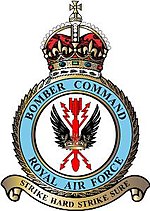RAF Bomber Command
| Bomber Command | |
|---|---|
 |
|
| Active | 14 July 1936–1968 |
| Country | United Kingdom |
| Branch | Royal Air Force |
| Role | Strategic bombing |
| Headquarters | 1936–40: RAF Uxbridge 1940–68: RAF High Wycombe |
| Motto(s) | Strike Hard Strike Sure |
| Engagements | Second World War |
| Battle honours | Berlin 1940–45 Fortress Europe 1940–44 |
| Commanders | |
| Notable commanders |
Air Marshal Charles Portal Air Chief Marshal Sir Arthur Harris |
| Aircraft flown | |
| Bomber |
1939: Battle, Blenheim, Hampden, Wellesley, Wellington, Whitley. 1942: Manchester, Stirling, Halifax, Lancaster, Mosquito. 1945: Lincoln 1950: Washington B.1 1951: Canberra. 1955: Vickers Valiant 1956: Avro Vulcan 1958: Handley Page Victor. |
1939: Battle, Blenheim, Hampden, Wellesley, Wellington, Whitley. 1942: Manchester, Stirling, Halifax, Lancaster, Mosquito.
1945: Lincoln
1950: Washington B.1
1951: Canberra.
1955: Vickers Valiant
1956: Avro Vulcan
RAF Bomber Command controlled the RAF's bomber forces from 1936 to 1968. Along with the United States Army Air Forces, it played the central role in the strategic bombing of Germany in World War II. From 1942 onward, the British bombing campaign against Germany became less restrictive and increasingly targeted industrial sites and the civilian manpower base essential for German war production. In total 364,514 operational sorties were flown, 1,030,500 tons of bombs were dropped and 8,325 aircraft lost in action. Bomber Command crews also suffered a high casualty rate: 55,573 were killed out of a total of 125,000 aircrew (a 44.4 percent death rate), a further 8,403 were wounded in action, and 9,838 became prisoners of war.
Bomber Command stood at the peak of its post-war military power in the 1960s, the V bombers holding the United Kingdom's nuclear deterrent and a supplemental force of Canberra light bombers.
...
Wikipedia
